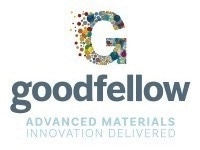Foam structures are both durable and lightweight, with a large surface area to volume ratio. The unique mechanical properties of aluminum foam include a high strength to weight ratio and a completely isotropic load response.
The foam also inherits a large number of the properties of its parent metal that include corrosion resistance, strength, electrical and thermal conductivity, but at a fraction of the weight. These foams find applications in structures such as heat exchangers and as substrates for catalytic converters.
Two Basic Foam Structures
Goodfellow offers two basic foam structures in a range of sizes and densities. The first form is stochastic or evenly sized, but with irregular shaped pores, also known as reticulated. The second form has regular, stacked cells.
Stochastic or Reticulated Foam
This foam is a skeletal structure, meaning it is not a metal coating on a base structure, but is instead a pure metal/alloy. The cells and ligaments form a regular, repeatable, regular and uniform matrix throughout the entirety of the material.
It is rigid with a highly porous and permeable structure. It exists in a range of densities and pore sizes.
Regular Stacked Cell Foam
This regular, stacked cell foam has evenly- spaced, open pores, defined as tetrakaidecahedrons, which are polygons with 14 faces - 8 hexagonal and 6 square. It can be imagined as a 3D honeycomb.
Sand casting is used to manufacture the foam and as such the exact form of the foam can be determined before its manufacture, and is repeatable in series: each manufactured piece will be identical and will therefore have exactly the same behavior.
Properties of Aluminum Foam
The properties of aluminium foam are shown in Table 1.
Table 1. Properties of Alumium foam
| CHARACTERISTICS |
Stochastic or reticulated foam |
Regular, stacked cell foam |
| Material |
Aluminium 98.5% (Aluminium 6101 alloy) |
Pure aluminium 99.5% (aluminium alloys on request) |
| Standard catalogue sizes |
3.2mm to 30mm thick x 150mm x 150mm (other sizes on request) |
40mm x 100mm x 172mm (other sizes on request) |
| Standard cladding |
None |
Aluminium, one side |
| Cladding thickness |
Not applicable |
4mm |
| Standard cell size |
2 to 16 pores/cm |
10mm |
| Other available cell sizes |
Not applicable |
14mm or on request |
| Foam topology |
Open, interconnected |
Open, stacked Kelvin cells |
| Relative density |
4 to 10% |
15% |
| Nominal Density (unclad foam) |
0.11 to 0.27 g/cm3 |
0.41 g/cm3 |
| Relative surface area |
200 to 2000 m2/m3 |
360 m2/m3 |
| Maximum service temperature |
450°C |
450°C |
| Melting point |
660°C |
660°C |
| Compression Strength |
2.53 MPa* |
4 MPa** |
| Tensile Strength* |
1.24 MPa* |
- |
| Shear Strength |
1.31 MPa* |
- |
| Modulus of Elasticity (Compression)* |
103.08 MPa* |
100 MPa (estimated) |
| Modulus of Elasticity (Tension)* |
101.84 MPa* |
100 MPa (estimated) |
| Shear Modulus |
199.95 MPa* |
48 MPa |
| Specific Heat |
0.895 J/g-C* |
0.9 J/g-C** |
| Bulk Thermal Conductivity |
5.8 W/m-C* |
15 W/m-C** |
| Coefficient of Thermal Expansion (0-100°C) |
23.58 x 10-6 m/m—C* |
- |
| Bulk Resistivity |
7.2 x 10-5 ohm - cm* |
- |
*8% nominal density
** AlSi7Mg (available to special order)
** 15% nominal density
Properties shown are typical values, they are not absolute material properties, and should be used for guidance only. It is recommended that materials and components are tested for their suitability for a specific application.
Applications
Typical applications of all foam types include:
- Sound absorption
- Fragmentation capture
- Impact absorption
- Heat sinks and exchangers
- Matrix for chemical beds and scrubbers
- Filters and mist elimination of water and oils
- Core structure for high strength panels
- Battery plates and spacers
- Weight reducing components in aircraft or automotive applications
- Catalyst surface
About Goodfellow

Goodfellow supplies metals, ceramics and other materials to meet the research, development and specialist production requirements of science and industry worldwide.
The Goodfellow group consists of four companies. The main administration, research laboratories and workshops are located at the Company's headquarters in Cambridge, England. The subsidiary offices in America, France and Germany provide an additional service.